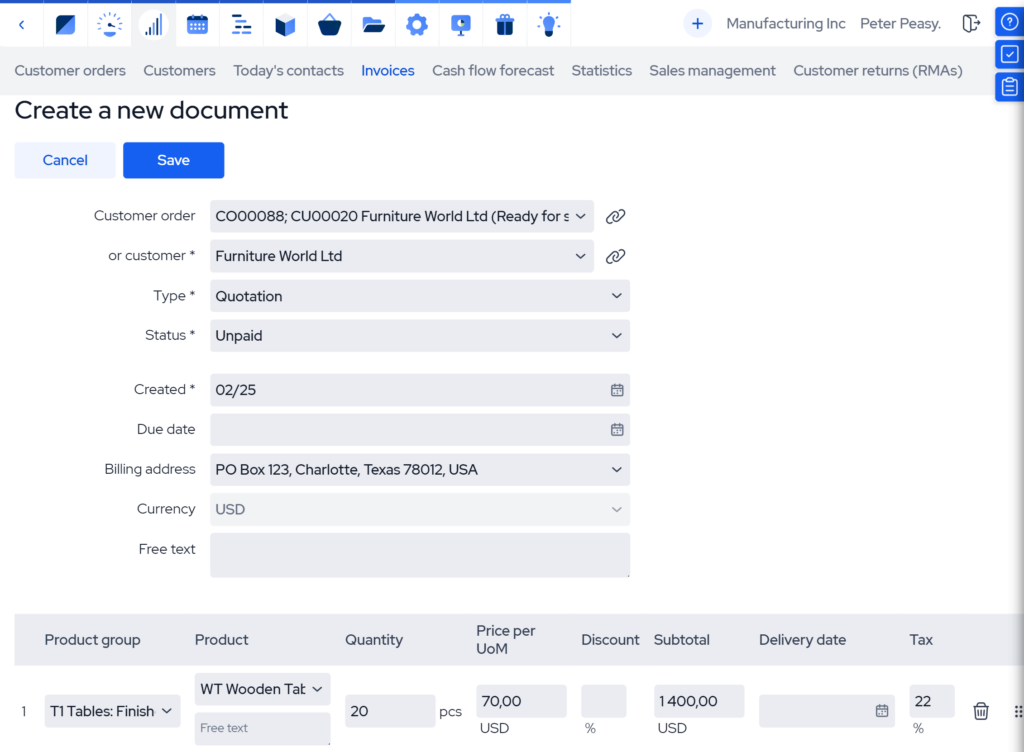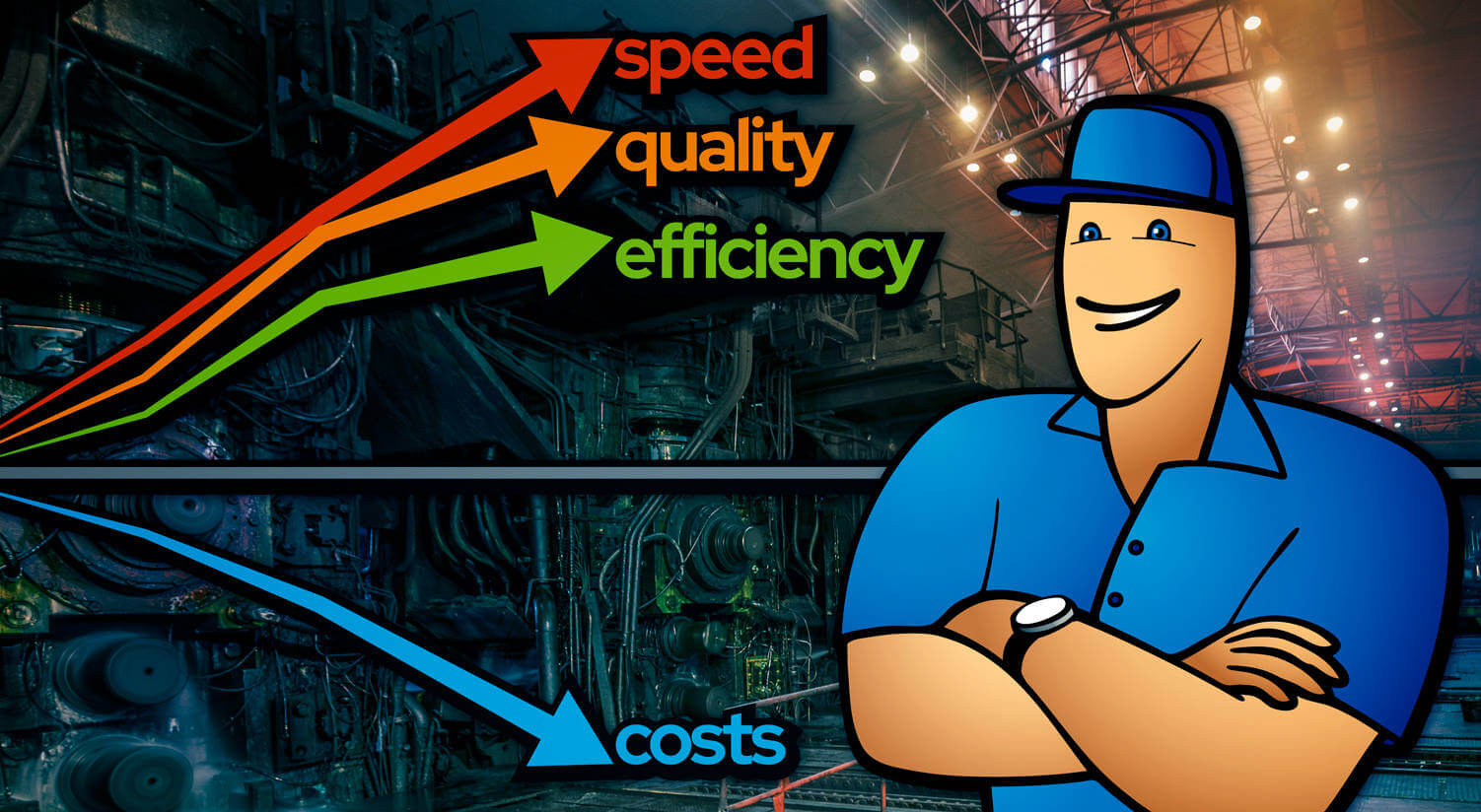Manufacturing Quoting – Improvement Tips for Small Businesses
Quoting is a crucial part of any manufacturing business – get it wrong, and you risk lost sales, wasted resources, and costly pricing mistakes. In this article, we explore the key aspects of manufacturing quoting and its common pitfalls and provide practical tips to improve the process.

What is manufacturing quoting?
Manufacturing quoting is the process of estimating and sharing the cost and delivery lead times for products requested by customers. It involves calculating labor, overhead, and material costs, as well as production time, to provide accurate estimates. Compiling quotes accurately is crucial, as mistakes can be costly and often negatively impact customer satisfaction.
Quoting involves multiple departments, including sales, production, and procurement. Sales teams gather customer requirements while the production department evaluates feasibility and schedules. Purchasing and supply chain management are often involved and tasked with ensuring material availability. Effective in-house collaboration is a must to ensure accurate quoting and requires considerable communication within a company.
The importance of accurate quotes in manufacturing
Quoting plays a more important role in manufacturing operations than might seem at first glance. Accurate cost estimating ensures profitability, competitiveness, and customer satisfaction. Once the agreed-upon price for a customer order is locked in, later surprises can be costly.
Accurate quoting:
- .. informs better pricing decisions. A well-structured quoting process ensures manufacturers price their products competitively while maintaining profitability. Accurate cost calculations and flexibility in the quoting process help prevent underpricing or overpricing.
- .. provides insight into demand. Requests for quotation (RFQs) give manufacturers an idea of customer needs and market trends. Analyzing quote data helps businesses anticipate demand, gain market insights, and optimize production planning accordingly.
- .. ensures flexibility toward customers. A quick and streamlined quoting process allows manufacturers to respond to customer requests more efficiently. This improves customer satisfaction and increases the chances of securing repeat orders.
- .. improves resource allocation. By minimizing unnecessary back-and-forth communication, companies can allocate resources more efficiently. This helps reduce manufacturing waste and enhances overall efficiency.
Manual vs. automated quoting systems
Manufacturers handle quoting in two main ways: the manual approach and the modern automated system. Each has its place, depending on the size of the operation, the complexity of the quotes, and the level of control a company wants over the process.
Manual quoting
Manual quoting relies on sales teams, engineers, and purchasing managers to bounce manufacturing data and other relevant information back and forth using spreadsheets, emails, and phonecalls. It’s a hands-on approach that gives manufacturers full control over the process, allowing them to tweak costs, adjust margins, and personalize quotes based on experience.
Manual quoting works well for businesses with a small product catalog or a steady stream of repeat customers with predictable orders. It can also be effective for highly project-based, custom manufacturing jobs and engineer-to-order workflows.
Manual quoting allows for more nuanced judgment, where human expertise plays a big role in pricing. However, because everything is entered manually, there’s a heightened risk of inconsistencies or delays, especially when handling custom orders or fluctuating material costs. It’s also much more time-consuming than using automated systems.
Automated quoting systems
Automated quoting systems, like CPQ (Configure, Price, Quote) software, take the manual work out of the equation. Instead of reconciling the latest material costs or digging through emails for past quotes, these systems pull data from a central source like an ERP system, CRM, or pricing database to generate quotes automatically.
This approach is better suited for manufacturers handling complex products, high quote volumes, or a high number of SKUs (stock keeping units), or for customers who expect fast turnaround times. The system ensures that pricing stays consistent, even when different salespeople are generating quotes. Automation additionally simplifies factoring in real-time changes in labor, materials, and overhead, so quotes remain accurate even if costs fluctuate.
Deciding on a quoting system is both a matter of preference and how a manufacturing operation is set up. Some businesses prefer manual quoting for its control and flexibility, while others are reliant on it due to a lack of sufficient manufacturing data automation. However, almost everyone can benefit from the speed and consistency of automated systems. For many, a hybrid approach works best, where automation handles the volume and data intricacies, but humans make the final adjustments.
Main issues within the quoting process
Quoting can be complicated, involving multiple teams, fluctuating costs, and varying customer expectations. Here are some of the biggest hurdles manufacturers face daily.
Manual and time-consuming processes
Gathering pricing details, checking stock availability, and waiting on internal approvals all prolong the quoting process. Overreliance on manual methods like spreadsheets or word of mouth can further slow it down and introduce inconsistencies, increasing the risk of errors. And in a competitive market, slow responses can often mean losing the job to someone faster.
Inaccurate or outdated data
Outdated or inaccurate data on pricing, materials, production schedules, or capacities will result in incorrect quotes, pure and simple. This inevitably impacts profitability and customer trust. According to Experian Data Quality, data inaccuracies cost manufacturing businesses remarkable amounts of money, up to 12% in lost revenue.
Handling complex products
Quoting becomes even trickier when dealing with highly customized or multi-component products. Every little adjustment, from material swaps to custom specifications, affects the final price. Tracking all these changes can be cumbersome, especially if done by hand. Constant recalculations or double-checking specs are signs that the process needs some streamlining.
Approval bottlenecks
After a quote is put together, it needs multilateral approval. This can take longer than expected, especially with more complex orders. For example, sales might want to check with engineering, or management may wish to review the pricing before committing. While oversight is important, drawn-out approval chains can frustrate customers who are ready to move forward.
Lack of historical data for optimization
If past quotes aren’t stored and their data made accessible in a structured way, some tasks are duplicated every time a new request comes in. Without an easy way to reference previous pricing, teams waste time recalculating costs that were already previously available. Or worse, they miss opportunities to refine their pricing strategies based on past data.
Material and cost fluctuations
Prices for raw materials, labor, and shipping fluctuate constantly. Quote systems that don’t account for this may regularly underprice jobs, thus absorbing the extra costs or overpricing and scaring customers away. Keeping quotes up-to-date with any market shifts is key to protecting profit margins.
7 tips for improving manufacturing quoting
Getting a quote right is as much about accuracy as it is about making sure customers get a fair but profitable deal. A few key changes can make the difference between a smooth quoting process and a chaotic one.
1. Always ensure data accuracy
Your quote is only as good as the data behind it. Material prices and manufacturing overheads fluctuate, and production schedules shift. If your system isn’t keeping up, you may be either underpricing, thereby losing profit, or overpricing and contributing to lost sales. Set a routine to keep cost data current and avoid outdated estimates.
2. Standardize quoting procedures
If different team members use different methods to generate quotes, pricing will be all over the place. A standardized quoting process helps keep things consistent, reducing discrepancies and ensuring every customer gets a reliable price. Whether it’s through templates, software, or strict internal guidelines, having a set process cuts down on confusion and errors.
3. Leverage historic quoting data
Avoid having to rework by starting from scratch every time. Keeping track of past quotes—especially for similar jobs—helps speed up the process while also helping to identify trends, adjust for market shifts, and refine margins based on real numbers instead of guesswork.
4. Measure and track quoting accuracy
If your final costs don’t match your quotes consistently, there’s a problem. Regularly compare quoted prices to actual job costs to see where you’re missing the mark. Tracking accuracy over time helps refine your pricing strategy, catch hidden expenses, and ensure you’re not slowly bleeding profit on miscalculated quotes.
Quoting related KPIs (key performance indicators) to consider tracking:
- Quote-to-order conversion rate. This tracks the percentage of quotes that turned into orders and may provide insights into the pricing strategy and customer trust.
- Average quote turnaround time. This KPI tracks how long it takes to generate and send a quote. Faster responses can improve conversion rates.
- Quote revision rate. This indicates how often quotes need adjustments before approval, pointing to inefficiencies in cost estimation or changing customer requirements.
- Margin accuracy. This KPI measures how close the actual profit margin is to the originally estimated margin in the quote, providing insight into production planning and cost-estimating accuracy.
5. Prioritize high-value orders and clients
A repeat customer with a large order probably deserves more attention than a one-off inquiry that may never convert. Allocating extra resources to high-value opportunities is smart and ensures that strategic customers get the fastest, most competitive quotes—keeping them satisfied and ensuring return business.
6. Consider establishing expedited pricing lists
Some customers need a quote fast and are often willing to pay a premium for it. Offering an expedited pricing option can help land urgent orders while justifying the extra effort required to fast-track production. A clear rush pricing structure keeps things fair and prevents last-minute requests from throwing off your workflow.
7. Automate the quoting system
Finally, automating parts or the entire quoting process has the most promise in increasing operational efficiency. If your team spends more time on spreadsheets, reconciling inaccuracies, or doing back-and-forths between departments than on actual sales, it’s time to bring in some automation. A good CPQ software streamlines calculations, pulls in real-time pricing, and helps ensure that every quote is accurate, consistent, and fast. It’s not about replacing people—it’s about equipping them with effective tools and freeing up time for more meaningful tasks.

Manufacturing quoting software for small manufacturers
For small manufacturers, quoting can feel like a constant trade-off—do you take the time to get every detail right, or do you rush to respond before the customer moves on? Is the process fast enough to win business or accurate enough to stay profitable?
Quoting software helps small businesses generate quotes quickly and accurately, eliminating guesswork or having to recalculate jobs every time. A good quoting system, especially when integrated into manufacturing ERP software, tracks customer quotes and sales orders, applies standardized pricing rules, helps keep material costs up to date, and much more. It simplifies the sales process and inventory management, automates data entry and manufacturing cost calculations, and provides a birds-eye-view of your entire manufacturing process.
With an integrating quoting functionality, small manufacturers can focus less on paperwork and more on delivering high-quality products and growing their business. The right system is much more than just accelerating the quoting process—it’s about building a smoother and more scalable operation.
Key takeaways
- Manufacturing quoting is the process of estimating costs and lead times for sales requests and sending them to customers. It involves calculating material, labor, and overhead expenses while ensuring competitive pricing and terms.
- An accurate quoting process improves pricing decisions and customer satisfaction. Clear and well-structured quotes help businesses secure orders, optimize resource allocation, and maintain profitability.
- Depending on a manufacturer’s needs, both manual and automated quoting systems have their place. Manual quoting allows for flexibility and control, while automated systems improve speed, consistency, and scalability, making them better suited for handling larger order volumes.
- Common quoting challenges include outdated data, approval bottlenecks, inconsistent pricing, and fluctuating material costs. These often lead to delays, lost revenue, and operational inefficiencies if not addressed consistently.
- Optimizing the quoting process through standardization, automation, and data accuracy leads to better business performance. Manufacturers can streamline operations and create a more competitive quoting system by leveraging technology, tracking quoting accuracy, and prioritizing high-value clients.
Frequently asked questions
A manufacturing quotation is an estimate of the cost and lead time required to produce a specific product or order. It includes material costs, labor expenses, overhead, and production time to ensure accurate pricing. A well-structured quote helps manufacturers stay competitive, maintain profitability, and build customer trust.
Manufacturing cost is calculated by adding up material costs, labor costs, and overhead expenses. Material costs include raw materials and components, labor costs cover wages for workers directly involved in production, and overhead includes utilities, equipment depreciation, and factory expenses.
Manufacturing estimating or quoting software helps businesses automate and streamline the quoting process. It calculates costs based on real-time material prices, labor rates, and overhead, reducing errors and improving accuracy. Many systems integrate with ERP or CRM software, enabling faster quotes, consistent pricing, and better decision-making for manufacturers.
Continue reading on our blog: What Is Job Costing and How to Get It Right?




